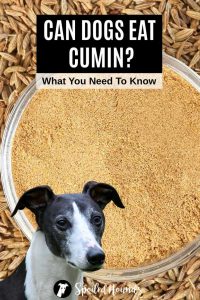Cumin, a pungent and aromatic spice, has long been celebrated for its distinctive flavor and versatility in culinary creations worldwide. From savory dishes to fragrant sauces, cumin adds depth and richness to a wide array of cuisines, including Indian, Mexican, Middle Eastern, and beyond. However, as dog lovers and responsible pet owners, it’s natural to wonder about the safety and suitability of sharing our culinary delights, such as cumin, with our furry companions.

In this article, we delve into the intriguing world of cumin and its potential implications for our canine friends. While cumin boasts a rich history of culinary use and is celebrated for its culinary prowess among humans, questions arise regarding its compatibility with the canine digestive system and overall health. Therefore, our exploration aims to address common questions and concerns related to feeding cumin to dogs, providing valuable insights to help pet owners make informed decisions about their dog’s diet and well-being. Let’s embark on this journey to unravel the mysteries surrounding cumin and its relationship with our beloved canine companions.
so come and join us to know everything about weather can dog eat Cumin or not?
Understanding Cumin:
Cumin, scientifically known as Cuminum cyminum, is a flowering plant native to regions of the eastern Mediterranean, Egypt, Iran, and India. Widely recognized for its warm, earthy flavor and distinct aroma, cumin is a staple spice in various cuisines around the world. In appearance, cumin seeds are small, elongated, and ridged, with a dark brown color.
Culinary Uses:
Cumin plays a pivotal role in enhancing the flavor profile of numerous dishes, including curries, stews, soups, rice dishes, and meat marinades. Its robust flavor pairs well with other spices like coriander, chili powder, and turmeric, contributing to the complex and savory taste of many traditional recipes.
Nutritional Value:
Cumin is not only valued for its culinary attributes but also for its nutritional content. It contains essential nutrients such as iron, manganese, calcium, magnesium, and vitamins A, C, and E. Additionally, cumin is rich in antioxidants and phytochemicals, which may have various health benefits for humans, including anti-inflammatory and digestive properties.
However, when it comes to dogs, the effects of cumin consumption are less understood, and caution is warranted. While cumin is generally considered safe for humans in moderate amounts, its impact on canine health requires further investigation. Therefore, pet owners should exercise prudence when considering incorporating cumin into their dog’s diet, and consulting with a veterinarian is advisable to ensure the safety and well-being of their furry companions.
Can Dogs Eat Cumin?

Many dog owners may wonder whether it’s safe to include cumin in their pet’s diet. While cumin is generally safe for human consumption and offers potential health benefits, its suitability for dogs is a topic of debate among veterinarians and pet nutrition experts. Here’s what dog lovers need to know:
Quantity and Preparation:
Cumin is often used in small quantities as a flavoring agent in various dishes. When considering whether to feed cumin to dogs, it’s essential to keep the quantity minimal and avoid using concentrated cumin extracts or supplements. Additionally, cumin seeds should be ground into a fine powder to prevent choking hazards and improve digestibility for dogs.
Potential Health Risks:
While cumin itself is not considered toxic to dogs, certain factors must be taken into account. Dogs may have individual sensitivities or allergies to spices, including cumin, which can lead to adverse reactions such as gastrointestinal upset, vomiting, diarrhea, or allergic dermatitis. Moreover, the presence of essential oils and compounds in cumin, such as cuminaldehyde, may irritate a dog’s digestive system in large quantities.
Consulting with a Veterinarian:
Before introducing cumin or any new food item into a dog’s diet, pet owners should consult with a veterinarian. A qualified veterinarian can provide personalized guidance based on a dog’s breed, age, health status, and dietary requirements. They can help assess the potential risks and benefits of incorporating cumin into a dog’s meals and recommend safe alternatives if necessary.
Ultimately, while cumin may offer flavor and nutritional benefits for humans, it’s essential to approach its inclusion in a dog’s diet with caution. Prioritizing the health and well-being of canine companions is paramount, and pet owners should always seek professional advice when in doubt about the suitability of specific foods for their dogs.
Nutritional Content of Cumin
Cumin, scientifically known as Cuminum cyminum, is a popular spice prized for its distinctive flavor and aroma. While commonly used in culinary dishes worldwide, cumin also offers a range of nutritional benefits. Here’s an overview of the nutritional content of cumin and its potential impact on a dog’s health:
Vitamins and Minerals:
Cumin contains various vitamins and minerals that contribute to its nutritional value. These include vitamin C, vitamin E, vitamin K, and several B vitamins such as thiamine, riboflavin, niacin, and vitamin B6. Additionally, cumin is rich in minerals like iron, calcium, magnesium, phosphorus, potassium, and zinc. These nutrients play essential roles in supporting a dog’s overall health, including bone strength, immune function, and energy metabolism.
Antioxidants:
Cumin contains potent antioxidants, including flavonoids, phenolic compounds, and volatile oils such as cuminaldehyde. These antioxidants help neutralize harmful free radicals in the body, reducing oxidative stress and inflammation. In dogs, antioxidants play a crucial role in maintaining cellular health, protecting against age-related diseases, and supporting longevity.
Health Benefits:
While research on the specific health benefits of cumin for dogs is limited, its nutritional profile suggests potential advantages. Cumin’s vitamin and mineral content may contribute to a balanced diet for dogs, supporting various physiological functions. Additionally, the presence of antioxidants in cumin may help promote overall well-being and protect against oxidative damage associated with aging and disease.
Cautionary Notes:
Despite its nutritional benefits, cumin should be used sparingly when feeding dogs. Introducing excessive amounts of cumin into a dog’s diet may lead to digestive upset or allergic reactions, particularly in sensitive individuals. Pet owners should always consult with a veterinarian before incorporating new foods, including spices like cumin, into their dog’s meals. Additionally, cumin should be ground into a fine powder to improve digestibility and prevent choking hazards for dogs.
While cumin offers nutritional value and potential health benefits, its inclusion in a dog’s diet should be approached with caution. By understanding its nutritional content and consulting with a veterinarian, pet owners can make informed decisions about incorporating cumin into their dog’s meals as part of a balanced and nutritious diet.
Health Benefits of Cumin for Dogs
Cumin, a versatile spice with a long history of culinary and medicinal use, may offer several potential health benefits for dogs. While scientific research specifically focused on cumin’s effects on canine health is limited, anecdotal evidence and studies on its bioactive compounds suggest possible advantages. Here’s an overview of the potential health benefits of cumin for dogs:
Anti-inflammatory Properties:
Cumin contains bioactive compounds such as cuminaldehyde, cuminol, and cuminic acid, which exhibit anti-inflammatory properties. These compounds may help reduce inflammation in the body, making cumin potentially beneficial for dogs with conditions such as arthritis, inflammatory bowel disease (IBD), or skin allergies. While more research is needed to confirm these effects specifically in dogs, incorporating small amounts of cumin into their diet may offer anti-inflammatory support.
Digestive Support:
Cumin has traditionally been used to aid digestion and alleviate gastrointestinal discomfort in humans. Similarly, dogs may benefit from cumin’s carminative properties, which can help reduce gas, bloating, and indigestion. The aromatic compounds in cumin may stimulate digestive enzymes, promoting efficient digestion and nutrient absorption. Additionally, cumin’s anti-inflammatory properties may help soothe gastrointestinal inflammation and improve overall digestive health in dogs.
Antioxidant Effects:
Cumin is rich in antioxidants, including flavonoids and phenolic compounds, which help neutralize harmful free radicals in the body. These antioxidants may offer protection against oxidative stress and cellular damage, supporting overall health and vitality in dogs. By scavenging free radicals, cumin’s antioxidant properties may help reduce the risk of chronic diseases, support immune function, and contribute to longevity in dogs.
While these potential health benefits are promising, it’s essential to note that individual responses to cumin may vary, and more research is needed to establish its efficacy and safety for dogs conclusively. Additionally, cumin should always be introduced in moderation and as part of a balanced diet, and pet owners should consult with a veterinarian before making any significant dietary changes or introducing new foods or supplements to their dog’s regimen.
Risks and Considerations:
Can Dog Eat Cumin ?While cumin may offer potential health benefits for dogs, there are also important risks and considerations to be aware of when incorporating this spice into their diet. Here’s an overview of the potential risks and considerations associated with feeding cumin to dogs:
Allergic Reactions:
Like humans, dogs can develop allergies to certain foods or spices, including cumin. Symptoms of a cumin allergy may include itching, redness, swelling, gastrointestinal upset, or even more severe reactions such as difficulty breathing or anaphylaxis. If a dog shows any signs of an allergic reaction after consuming cumin or foods containing cumin, it’s crucial to discontinue feeding it and consult a veterinarian promptly.
Digestive Upset:
Introducing cumin to a dog’s diet in excessive amounts or too quickly may lead to digestive upset, including symptoms such as diarrhea, vomiting, or abdominal discomfort. Dogs with sensitive stomachs or underlying gastrointestinal conditions may be particularly prone to digestive disturbances when exposed to new foods or spices. It’s essential to introduce cumin gradually and in moderation, monitoring the dog’s response closely to prevent gastrointestinal issues.
Toxicity Concerns:
While cumin is generally considered safe for dogs in small quantities, excessive consumption may lead to toxicity. Cumin contains compounds such as cuminaldehyde and cuminol, which, when ingested in large amounts, could potentially cause adverse effects such as liver damage or gastrointestinal irritation. However, toxic effects from cumin are rare and typically occur only with substantial ingestion. Nevertheless, it’s essential to avoid overfeeding cumin to dogs and to stick to recommended serving sizes.
Individual Sensitivities:
Every dog is unique, and individual sensitivities to cumin may vary. Some dogs may tolerate cumin well, while others may experience adverse reactions even to small amounts. Factors such as age, breed, overall health status, and pre-existing medical conditions can influence a dog’s tolerance to cumin. Pet owners should be attentive to their dog’s response when introducing cumin into their diet and consult with a veterinarian if any concerns arise.
Overall, while cumin can be included in a dog’s diet in moderation and as part of a varied and balanced nutrition plan, it’s essential to exercise caution and monitor for any signs of adverse reactions. As with any dietary change or addition, consulting with a veterinarian is recommended to ensure the safety and well-being of the dog.
Expert Opinions and Recommendations
Seeking insights from veterinary professionals or animal nutritionists can provide valuable guidance on whether and how to incorporate cumin into a dog’s diet safely. Here’s an overview of expert opinions and recommendations regarding the use of cumin for dogs:
Veterinary Perspective:
Veterinarians are valuable resources for pet owners seeking guidance on dietary choices for their dogs. While opinions may vary among individual veterinarians, many experts agree that cumin is generally safe for dogs when fed in moderation. However, they may caution against excessive consumption or the use of cumin in dogs with specific health conditions or sensitivities. Consulting with a veterinarian can help pet owners make informed decisions about whether cumin is suitable for their dog’s individual needs.
Animal Nutritionists’ Insights:
Animal nutritionists specialize in the dietary requirements of pets and can offer tailored recommendations for incorporating specific ingredients into a dog’s diet. When it comes to cumin, nutritionists may emphasize its potential health benefits, such as its anti-inflammatory properties or digestive support. They may also provide guidelines on appropriate serving sizes and frequency of cumin intake based on factors like the dog’s size, age, activity level, and overall health status.
Recommendations for Pet Owners:
Based on expert opinions and recommendations, pet owners can make informed decisions about whether to include cumin in their dog’s diet. If a veterinarian or animal nutritionist determines that cumin is appropriate for a particular dog, they may offer specific guidelines on how to introduce and incorporate cumin safely. This may include starting with small amounts to gauge the dog’s tolerance, monitoring for any adverse reactions, and adjusting the serving size as needed. Additionally, pet owners should prioritize variety and balance in their dog’s diet, ensuring that cumin is just one component of a nutritionally complete and well-rounded meal plan.
Overall, seeking expert opinions and recommendations from veterinary professionals or animal nutritionists can help pet owners make informed choices about whether and how to include cumin in their dog’s diet. By following expert guidance and monitoring their dog’s response, pet owners can ensure the safety and well-being of their furry companions.
Conclusion: Making Informed Choices
In conclusion, exploring the topic of feeding cumin to dogs has provided valuable insights into the potential benefits and risks associated with this popular spice. Here’s a summary of key points discussed in the article:
Safety Considerations:
While cumin is generally considered safe for dogs when fed in moderation, there are important factors to consider. These include the dog’s individual sensitivities, existing health conditions, and the quantity and frequency of cumin consumption. Pet owners should be mindful of potential risks such as allergic reactions, digestive upset, and toxicity concerns, and consult with a veterinarian before incorporating cumin into their dog’s diet.
Health Benefits:
Cumin offers potential health benefits for dogs, including anti-inflammatory properties and digestive support. However, these benefits may vary depending on factors such as the dog’s age, size, and overall health status. Pet owners should consider these factors when deciding whether to include cumin in their dog’s diet and seek guidance from veterinary professionals or animal nutritionists.
Expert Recommendations:
Consulting with veterinary professionals or animal nutritionists can provide valuable guidance on whether and how to incorporate cumin into a dog’s diet safely. These experts can offer tailored recommendations based on the dog’s individual needs and provide guidelines on appropriate serving sizes and frequency of cumin intake.
Prioritizing Pet Health:
Ultimately, the health and well-being of our canine companions should be the top priority. Pet owners are encouraged to make informed choices about their dog’s diet, consulting with their veterinarian before introducing cumin or any new ingredient. By prioritizing their pet’s health and well-being, dog owners can ensure that their furry friends receive the nutrition they need to thrive.
In conclusion, making informed choices about feeding cumin to dogs involves careful consideration of safety, health benefits, and expert recommendations. By consulting with veterinary professionals and prioritizing their pet’s health, dog owners can make decisions that support their furry companion’s overall well-being and happiness.






